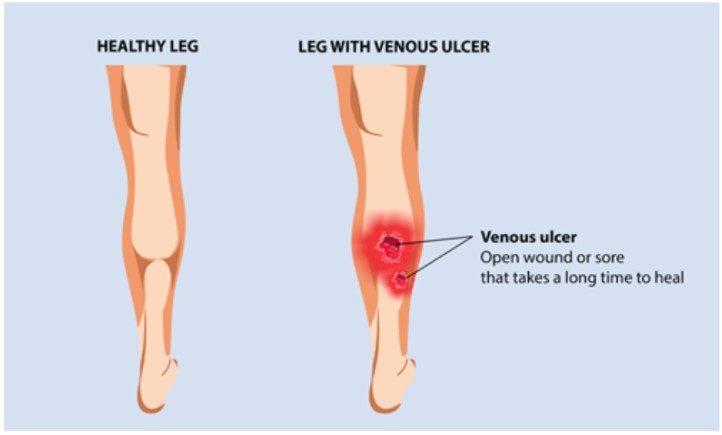
ROLE OF CHITOSAN WOUND DRESSING
IN POST-TRAUMATIC LEG ULCER
Open lesions between the knee and ankle joint (the gaiter area) are known as venous leg ulcers/ traumatic leg ulcers (VLUs), (TLUs) (Fig 1)¹. They frequently happen on the medial and lateral faces when there is venous insufficiency of the leg. They are also known as varicose or stasis ulcers, and they often have superficial borders, a wound bed that granulates, and moderate to high exudate levels.² Diabetic foot ulcers and venous leg ulcers are both types of chronic wounds.
One percent of people will get a venous leg ulcer in their lifetime.³ They are the most common cause of leg ulcers, accounting for 60-80% of them. The prevalence of TLUs is between 0.18% and 1%. Over the age of 65, the prevalence increases to 4%. On an average 33-60% of these ulcers persist for more than 6 weeks and are therefore referred to as chronic TLUs.⁴
Wounds can be categorized based on the layers of tissue they involve. Superficial wounds affect only the epidermis, partial thickness wounds affect both the epidermis and dermis, and full-thickness wounds extend into the subcutaneous fat or deeper tissues. While the body naturally strives to restore tissue continuity after an injury, various factors like infection, the quality and speed of healing, fluid loss, and other complications can significantly impact the healing process, posing significant clinical challenges.⁵
Most wounds heal without complications. However, the greatest challenge in wound care research arises from chronic non-healing wounds that progressively involve more tissue loss. Unlike surgical incisions, which typically involve minimal tissue loss and are relatively easy to heal, chronic wounds disrupt the normal healing process and often require additional interventions for repair. Delayed healing is commonly associated with compromised wound physiology and is frequently seen in conditions such as venous stasis, diabetes, or prolonged local pressure.⁵
Another significant challenge in wound care is the prevention of scarring, keloid formation, or contractures, aiming for a cosmetically acceptable healing outcome.⁵
Healthcare professionals are increasingly advocating for the adoption of advanced dressings due to their favorable attributes for healing. These advanced dressings not only facilitate a more conducive healing environment but also necessitate fewer dressing changes, leading to reduced care requirements. Moreover, their ability to expedite the healing process translates into a decreased demand for resources. An analysis of the wound care market underscores the ongoing transition towards the use of advanced wound dressings.⁵
One such advanced wound dressing is MaxioCel Chitosan Wound Dressing. Maxiocel is a non-woven microfiber dressing made up of 100% Chitosan, is a highly absorbent antimicrobial dressing with pain reduction and scar improvement properties. It can be used for moderate to heavily exuding wounds of varied depth, shape, and size. MaxioCel is the next-generation wound care dressing for both acute and chronic wound management, it utilizes Bioactive Microfiber Gelling (BMG) Technology. The BMG dressing not just offers superior exudate absorption and locking properties but also possesses excellent anti-microbial properties and promotes wound healing at the cellular level. BMG technology-based gelling action in combination with unique molecular chemistry of biopolymer induces higher absorbency and mechanical strength to MaxioCel and facilitates the creation of an optimal environment for rapid wound healing. Its fluid retention prevents wound maceration as well, keeping the wound clean and sufficiently moist. (Fig 2).⁶
 Figure 2: Scar improvement comparison between cotton gauze and MaxioCel
Figure 2: Scar improvement comparison between cotton gauze and MaxioCel
Recently, Bioactive Microfiber Gelling (BMGTM) technology based MaxioCel dressing, was administered on a patient suffering from Venous Leg Ulcers (in the ankle) for 2 months (Chronic) Ulcers on the ankle measured 5cm X 3cm X 0.5cm (length X width X depth) Patient (26 years, Male). MaxioCel was used on the leg for 2 weeks and it was observed that the dressing managed wound exudates very well and the patient did not feel any pain while using or removal of the dressing. At the end of 2 weeks, there was epithelization and scar improvement.⁴ (Fig 3.)
Overall, Maxiocel was also found to be an excellent chitosan wound dressing in patients suffering from Venous Leg Ulcers.
References:
- Heavy legs. Venous leg ulcer image.
- Fibrin cuff theory. www.magonlinelibrary.com (2018).
- Lim, C. S., Baruah, M. & Bahia, S. S. Diagnosis and management of venous leg ulcers. BMJ (Online) 362, (2018).
- MAXIOCEL CLINICAL CASE STUDIES POST-TRAUMATIC LEG ULCERS MAXIOCEL-100% CHITOSAN WOUND DRESSING ON POST-TRAUMATIC LEG ULCERS. www.axiostat.com.
- Paul, W. Chitosan and Alginate Wound Dressings: A Short Review Enteric Coating of Polyclonal Antibody for Colon Delivery View project. http://www.sbaoi.org.
6. Axio Biosolutions. Bioactive Microfiber Gelling Technology.
 A collaborative study with Harvard Medical School
A collaborative study with Harvard Medical School


